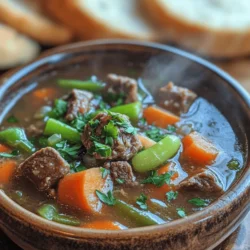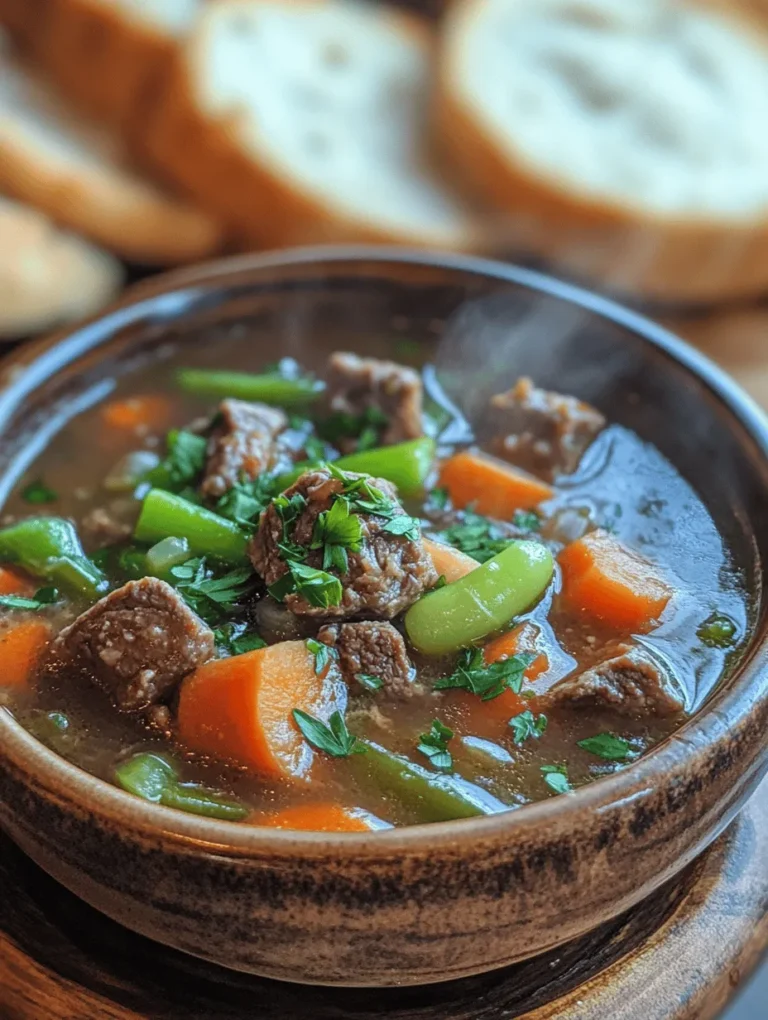When the chill of winter settles in, there’s nothing quite like a steaming bowl of homemade soup to provide warmth and comfort. The essence of comfort food lies in its ability to nourish both the body and soul, creating a sense of home even on the coldest days. Among the myriad of soup options, Hearty Vegetable Beef Soup stands out as a quintessential dish—rich in flavor, loaded with nutrients, and brimming with the heartiness that only beef can provide. Whether you’re searching for a way to warm up after a day outdoors or simply looking to indulge in a comforting meal, this soup is the perfect solution.
One of the most significant advantages of making homemade soup is the control it gives you over the ingredients. When preparing your own Hearty Vegetable Beef Soup, you can select the freshest vegetables, choose high-quality beef, and adjust the seasonings to your liking. This not only ensures that your soup is delicious but also allows you to cater to your nutritional needs. With the ability to incorporate a variety of vegetables and herbs, this recipe becomes not only a comfort dish but also a nourishing option that supports your health.
In this article, we’ll dive into the key components of Hearty Vegetable Beef Soup, understanding the role each ingredient plays in creating its robust flavor profile and nutritional benefits. We’ll also guide you through the preparation steps, ensuring that you have the skills necessary to create this delightful soup in your own kitchen.
Understanding the Ingredients
To truly appreciate the depth of flavor and health benefits of Hearty Vegetable Beef Soup, it’s essential to understand the ingredients that come together to create this dish. Each component plays a strategic role, contributing not only to the soup’s taste but also to its nutritional value.
Overview of Beef Stew Meat
At the heart of Hearty Vegetable Beef Soup is the beef stew meat. Typically, this cut comes from tougher parts of the cow, such as the chuck or round, which contain more connective tissue and require slow cooking to become tender. When simmered for an extended period, the collagen in the meat breaks down, enriching the broth with a deep and savory flavor. Additionally, beef is a great source of protein, iron, and several essential vitamins, making it a vital ingredient for a satisfying meal.
Nutritional Benefits of Vegetables
The vegetable medley in this soup isn’t just there for flavor; it adds an array of nutrients that enhance the dish’s overall health benefits. By incorporating a variety of vegetables, you can ensure a colorful and nutrient-rich bowl.
– Onions and Garlic: These aromatics form the foundation of flavor in many soups. Onions add sweetness and depth, while garlic brings a pungent, savory note. Both ingredients are known for their health benefits, including anti-inflammatory properties and potential heart health advantages.
– Carrots and Celery: Carrots offer a natural sweetness and are packed with beta-carotene, which is converted to vitamin A in the body, supporting vision and immune function. Celery, on the other hand, adds crunch and is a good source of vitamins K and C, as well as potassium, contributing to heart health.
– Bell Peppers: These colorful vegetables are rich in vitamins A and C, as well as antioxidants. Their sweetness balances the savory elements of the soup and adds vibrant color, making the dish visually appealing.
– Green Beans: These tender vegetables not only contribute a satisfying texture but also provide fiber and vitamins A, C, and K. Green beans are low in calories yet high in nutrients, making them an excellent addition to the soup.
The Importance of Herbs and Spices
Herbs and spices are what elevate Hearty Vegetable Beef Soup from a simple dish to a flavor powerhouse.
– Thyme and Oregano: These herbs are staples in many savory dishes and for good reason. Thyme has a slightly earthy flavor that pairs well with beef, while oregano adds a hint of warmth and a touch of the Mediterranean. Together, they enhance the overall flavor profile of the soup.
– Bay Leaf: Adding a bay leaf during the simmering process infuses the broth with a subtle bitterness and complexity. It’s typically removed before serving but plays a crucial role in flavor development.
Preparation Steps Explained
Creating a pot of Hearty Vegetable Beef Soup is not only rewarding but also an excellent way to practice your cooking skills. Below, we break down the preparation steps to ensure you can replicate this comforting dish with ease.
Browning the Beef: Techniques for Depth of Flavor
The first step in making Hearty Vegetable Beef Soup is browning the beef. This technique is essential for developing a deep, rich flavor. Begin by cutting the beef stew meat into uniform pieces, which will ensure even cooking. Pat the meat dry with paper towels to remove excess moisture—this step is crucial for achieving a good sear.
Heat a heavy-bottomed pot or Dutch oven over medium-high heat and add a tablespoon of oil. Once the oil is shimmering, add the beef in batches to avoid overcrowding. Allow the meat to sear undisturbed for a few minutes until a golden-brown crust forms. This browning process not only enhances the flavor through the Maillard reaction but also helps to create a rich base for the soup. Remove the browned beef from the pot and set it aside.
Sautéing Vegetables: Layering Flavors
After the beef is browned, it’s time to sauté the vegetables. In the same pot, add a bit more oil if necessary, then toss in the chopped onions and garlic. Sauté these aromatics until the onions are translucent and fragrant, about 3-5 minutes. This step is essential for building the foundational flavor of the soup.
Next, add the carrots, celery, and bell peppers to the pot, stirring to combine. Sauté the vegetables for another 5-7 minutes until they begin to soften. Layering flavors through this sautéing process helps to unlock the natural sugars in the vegetables, creating a more complex and satisfying taste in the final soup.
Combining Ingredients: When to Add What
Once the vegetables are sautéed, it’s time to bring all the components together. Return the browned beef to the pot and pour in your choice of broth—beef broth works best for this recipe, but vegetable broth can be used for a lighter version. The broth not only adds moisture but also infuses the soup with additional flavor.
At this stage, it’s important to add the herbs and spices. Toss in the thyme, oregano, and bay leaf, along with any additional seasonings you prefer, such as salt and pepper. Stir everything together, allowing the flavors to meld before proceeding to the next step.
Simmering the Soup: The Magic of Slow Cooking
With all the ingredients combined, bring the soup to a gentle boil. Once boiling, reduce the heat to low, cover the pot, and let it simmer. Slow cooking is where the magic happens—allowing the flavors to develop and the beef to become tender. Ideally, you should let the soup simmer for at least an hour, but longer cooking times will yield even richer flavors. If you have the time, simmering for 2-3 hours can result in a truly exceptional bowl of soup.
Final Touches: Perfecting the Seasoning
As the soup simmers, take the opportunity to taste and adjust the seasoning. The flavors will evolve, so it’s essential to check for balance. You might find that a little extra salt or a dash of hot sauce can elevate the soup further. Just before serving, remove the bay leaf and any herb stems, ensuring a smooth and enjoyable texture.
By following these steps, you’ll create a Hearty Vegetable Beef Soup that is not only delicious but also nourishing, perfect for warming up during those chilly months. As you enjoy the fruits of your labor, you’ll appreciate the comforting aromas and flavors that fill your kitchen. In the next section, we will delve into the nutritional analysis of this hearty soup, demonstrating just how beneficial it can be for your health.
Nutritional Breakdown of Hearty Vegetable Beef Soup
When it comes to comfort food, few dishes can rival the wholesome goodness of Hearty Vegetable Beef Soup. Not only is this recipe satisfying for the palate, but it also offers impressive health benefits. Let’s delve deeper into the nutritional aspects of this dish.
Caloric Content and Macronutrients
A serving of Hearty Vegetable Beef Soup (approximately 1 cup) generally contains around 200-250 calories. This caloric range can vary depending on the specific ingredients and portion sizes used. The macronutrient distribution typically breaks down as follows:
– Protein: Approximately 15-20 grams per serving. The beef provides a substantial protein boost essential for muscle repair and overall body function.
– Carbohydrates: Around 20-30 grams, primarily from the vegetables and any added grains such as barley or potatoes. These carbohydrates offer sustained energy.
– Fats: About 5-10 grams, largely from the beef and any added oils. Using lean cuts of beef can help keep the fat content lower while ensuring a rich flavor.
This balance makes the soup an excellent choice for a fulfilling meal that doesn’t compromise nutritional value.
Vitamins and Minerals Offered by the Ingredients
Hearty Vegetable Beef Soup is not only filling but also packed with vitamins and minerals:
– Vitamin A: Carrots, bell peppers, and leafy greens contribute to a significant intake of Vitamin A, which is vital for eye health and immune function.
– Vitamin C: Ingredients like tomatoes and bell peppers are rich in Vitamin C, which is essential for skin health and boosts immunity.
– Iron: Beef is a fantastic source of iron, necessary for producing hemoglobin in the blood, while vegetables like spinach add additional iron along with Vitamin C for better absorption.
– Potassium: The variety of vegetables, especially potatoes and carrots, contribute to potassium intake, which is important for heart health and muscle function.
Incorporating this soup into your diet can help meet daily nutritional needs while providing essential dietary fiber, which aids in digestion.
How This Soup Fits Into a Balanced Diet
Hearty Vegetable Beef Soup is versatile enough to fit into various dietary plans. It can serve as a main dish, providing protein and fiber, or as a side to accompany a lighter meal. With its rich vegetable content, this soup promotes the recommended daily intake of vegetables, making it a great option for anyone looking to increase their plant consumption.
Moreover, its relatively low-calorie count makes it suitable for those monitoring their weight while still delivering a sense of fullness and satisfaction.
Serving Suggestions and Pairings
To elevate your dining experience, consider how you serve Hearty Vegetable Beef Soup and what you pair it with.
Recommended Side Dishes
While the soup can certainly stand alone, pairing it with light side dishes can enhance the meal’s overall appeal. Here are a few suggestions:
– Garden Salad: A fresh garden salad with a tangy vinaigrette can provide a refreshing contrast to the warm, hearty soup.
– Roasted Vegetables: Seasoned and roasted seasonal vegetables can complement the flavors of the soup and add more nutrients to your meal.
– Grilled Cheese Sandwich: A classic pairing, a crispy grilled cheese sandwich offers a delightful crunch and flavor that perfectly contrasts the soup’s warmth.
Suggestions for Bread or Crackers
Bread or crackers add a wonderful texture to the meal. Consider these options:
– Crusty Artisan Bread: A thick slice of sourdough or whole grain bread can be perfect for dipping.
– Garlic Bread: The buttery, garlicky flavor of garlic bread pairs beautifully with the savory notes of the soup.
– Whole Wheat Crackers: For a lighter option, serve with whole wheat crackers for a satisfying crunch.
Ideal Occasions for Serving
Hearty Vegetable Beef Soup is incredibly versatile and suitable for various occasions:
– Family Gatherings: The soup is perfect for family dinners, providing a comforting meal that everyone will enjoy.
– Rainy Days: There’s nothing quite like a warm bowl of soup on a chilly day; it’s an ideal remedy for dreary weather.
– Meal Prep: Make a large batch over the weekend for quick, nutritious lunches during the week. The flavors develop even more after a day in the fridge!
Variations and Customizations
Encouraging creativity in the kitchen can lead to delightful surprises. Here are some variations and customizations to consider for your Hearty Vegetable Beef Soup:
Alternative Proteins: Chicken or Plant-based Options
While beef is traditional, you can easily switch up the protein:
– Chicken: Use shredded rotisserie chicken or bite-sized pieces of grilled chicken breast for a lighter version of the soup.
– Plant-based Proteins: For a vegetarian or vegan twist, substitute beef with lentils, chickpeas, or tempeh. These options not only provide protein but also add a unique texture.
Seasonal Vegetables to Include
Take advantage of seasonal produce to enhance the soup’s flavor and nutrition:
– Winter: Add root vegetables like turnips or parsnips for extra heartiness.
– Spring: Incorporate fresh peas and asparagus for a vibrant touch.
– Summer: Zucchini and corn can provide a fresh burst of flavor and sweetness.
– Fall: Add pumpkin or sweet potatoes for a rich, autumnal flavor.
Spicing Things Up: Heat Levels and Flavor Adjustments
If you enjoy a little kick, consider adjusting the spice levels:
– Add Heat: Incorporate red pepper flakes or diced jalapeños for a spicy kick.
– Herbs and Spices: Fresh herbs like thyme, rosemary, or bay leaves can deepen the flavor profile. Experiment with smoked paprika or cumin for a unique twist.
Storing and Reheating Your Soup
Proper storage and reheating practices ensure that your Hearty Vegetable Beef Soup remains delicious for days to come.
Best Practices for Refrigeration
– Cooling: Allow the soup to cool to room temperature before refrigerating to ensure food safety.
– Containers: Store in airtight containers to prevent moisture loss and maintain freshness. The soup can last for up to 3-4 days in the refrigerator.
Freezing the Soup for Future Meals
For longer storage, freezing is a great option:
– Freezing: Portion out the soup into freezer-safe containers or zip-top bags, leaving some space for expansion.
– Labeling: Clearly label with the date and contents so you can easily identify it later. The soup can be frozen for up to 3 months.
Reheating Guidelines for Optimal Flavor
When it’s time to enjoy your soup again, reheating properly can preserve its flavor and texture:
– Stovetop: For best results, reheat on the stovetop over medium heat, stirring occasionally until heated through.
– Microwave: If using a microwave, transfer to a microwave-safe bowl and heat in 1-minute intervals, stirring in between to ensure even heating.
Conclusion: Embracing Homemade Soup
Hearty Vegetable Beef Soup is more than just a meal; it is a celebration of wholesome ingredients and the joy of cooking. This dish embodies warmth, nourishment, and the comfort of home-cooked food. The process of making soup provides an opportunity to bond with loved ones, share stories, and create lasting memories around the dinner table.
As you embrace the art of homemade soup, consider the versatility and satisfaction that each bowl offers. Whether enjoyed on a rainy day, shared with family, or prepared in advance for busy weeks, this soup is sure to warm hearts and fill bellies. So gather your ingredients, unleash your creativity, and enjoy every comforting spoonful of Hearty Vegetable Beef Soup!



